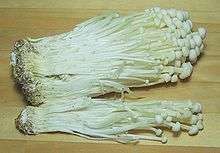Enokitake
Enoki (Flammulina velutipes), also known as velvet shank, is a species of edible mushroom in the family Physalacriaceae. It is well-known for its role in Japanese cuisine, where it is also known as Enokitake (榎茸, エノキタケ, Japanese pronunciation: [enoki̥ꜜtake]).[1]
| Enokitake | |
|---|---|
 | |
| Cultivated Flammulina velutipes | |
| Wild enokitake, Flammulina velutipes | |
| Scientific classification | |
| Kingdom: | |
| Division: | |
| Class: | |
| Order: | |
| Family: | |
| Genus: | |
| Species: | F. velutipes |
| Binomial name | |
| Flammulina velutipes | |
| Synonyms | |
| |
Features
The mushroom naturally grows on the stumps of the Chinese hackberry tree (Celtis sinensis, "enoki" in Japanese) and on other trees, such as ash, mulberry and persimmon trees.
There is a significant difference in appearance between the wild and cultivated types of the mushroom. Cultivated mushrooms have not been exposed to light, resulting in a white color, whereas wild mushrooms usually display a dark brown color. Cultivated mushrooms are grown in a carbon dioxide (CO2)-rich environment to nurture the development of long thin stems, whereas wild mushrooms produce a much shorter and thicker stem.
The wild variety of the mushroom may be found from September through to March, hence the name winter fungus.
When picking it in the wild, it is important not to confuse it with the poisonous Galerina marginata. Flammulina velutipes can be distinguished by its shiny and sticky caps, white spores, and the absence of a ring on the stem. Galerina marginata presents brown caps and stipe and most notably has brown, rusty spores. It also tends to grow isolated and it presents a ring. Commercially farmed enoki is a long, thin white mushroom and is a popular ingredient for soups, especially in East Asian cuisine, but can be used for salads and other dishes. The mushroom has a crisp texture and can be refrigerated for approximately one week. The farmed form is also known as golden needle mushroom, futu mushroom or lily mushroom. The farmed F. velutipes is sold both fresh and canned.
The wild forms differ in color, texture, and sliminess and may be called futu, seafood mushrooms, winter mushrooms or winter fungus, velvet foot, velvet stem or velvet shank.[2]
Names
| Flammulina velutipes | |
|---|---|
float | |
| gills on hymenium | |
| cap is convex | |
| hymenium is adnexed | |
| stipe is bare | |
| spore print is white | |
| ecology is saprotrophic | |
| edibility: choice | |
The names enokitake (榎茸、エノキタケ), enokidake (榎茸、エノキダケ) and enoki (榎、エノキ) are derived from the Japanese language. In Mandarin Chinese, the mushroom is called 金針菇 (jīnzhēngū, "gold needle mushroom") or 金菇 (jīngū, "gold mushroom"). In India it is called futu, in Korean, it is called paengi beoseot (팽이버섯) which means "mushroom planted near catalpa", and nấm kim châm in Vietnamese. In Hungary it is called téli fülőke, meaning "winter ear".
Edibility and health
Flammulina velutipes is edible but may have a soft or slimy texture.[3]
Enokitake mushrooms contain antioxidants,[4][5] like ergothioneine.[5] Animal testing has indicated possible applications in the development of vaccines and cancer immunotherapy.[6]
Research at the National University of Singapore, first published in 2005, stated that the stalk of the golden needle mushroom contains a large quantity of a protein, named "Five"/"FIP-fve" by the researchers, that helps in the regulation of the immune system. The mushroom also contains flammutoxin, a cytolytic and cardiotoxic protein[7][8] that has proven to be non-toxic when absorbed/taken orally.[9]
The cardiotoxin flammutoxin has been isolated from Enokitake.[10]
See also
- Edible mushrooms
- Medicinal mushrooms
References
- Dictionary.com (2012). "enokitake". Dictionary.com. Dictionary.com, LLC. Retrieved 14 May 2012.
- Shanghai Xuerong Biotechnology Co Ltd on Seafood Mushrooms
- Meuninck, Jim (2017). Foraging Mushrooms Oregon: Finding, Identifying, and Preparing Edible Wild Mushrooms. Falcon Guides. p. 118. ISBN 978-1-4930-2669-2.
- Bao HN, Ushio H, Ohshima T (March 2009). "Antioxidative activities of mushroom (Flammulina velutipes) extract added to bigeye tuna meat: dose-dependent efficacy and comparison with other biological antioxidants". Journal of Food Science. 74 (2): C162–9. doi:10.1111/j.1750-3841.2009.01069.x. PMID 19323731.
- Bao HN, Ushio H, Ohshima T (November 2008). "Antioxidative activity and antidiscoloration efficacy of ergothioneine in mushroom (Flammulina velutipes) extract added to beef and fish meats". Journal of Agricultural and Food Chemistry. 56 (21): 10032–40. doi:10.1021/jf8017063. PMID 18841979.
- "New look at two wonder mushrooms". National University of Singapore. 2001–2012. Retrieved 14 May 2012.
- Tomita T, Ishikawa D, Noguchi T, Katayama E, Hashimoto Y (July 1998). "Assembly of flammutoxin, a cytolytic protein from the edible mushroom Flammulina velutipes, into a pore-forming ring-shaped oligomer on the target cell". The Biochemical Journal. 333 (1): 129–37. doi:10.1042/bj3330129. PMC 1219565. PMID 9639572.
- Lin, JY; Wu, HL; Shi, GY (November 1975). "Toxicity of the cardiotoxic protein flammutoxin, isolate from edible mushroom Flammulina velutipes". Toxicon. 13 (5): 323–31. doi:10.1016/0041-0101(75)90191-9. PMID 54950.
- Tomita, Toshio; Dai Ishikawa; Takayasu Noguchi; Eisaku Katayama; Yohichi Hashimoto (8 April 1998). "Assembly of flammutoxin, a cytolytic protein from the edible mushroom Flammulina velutipes, into a pore-forming ring-shaped oligomer on the target cell". Biochemical Journal. 333 (333): 129–137. doi:10.1042/bj3330129. PMC 1219565. PMID 9639572.
- Bernheimer, A. W.; Oppenheim, J. D. (1987). "Some properties of flammutoxin from the edible mushroom Flammulina velutipes". Toxicon. 25 (11): 1145–1152. doi:10.1016/0041-0101(87)90132-2. PMID 3433291.
External links
